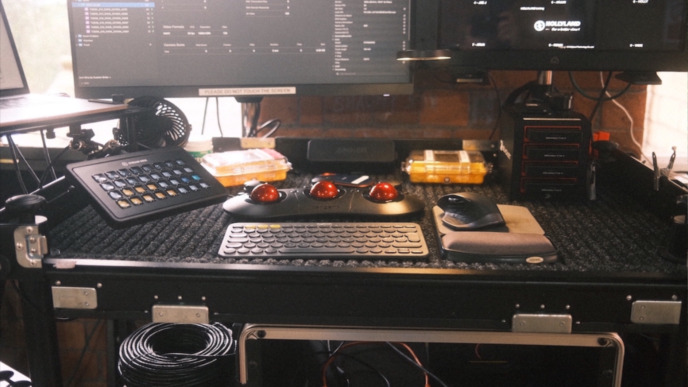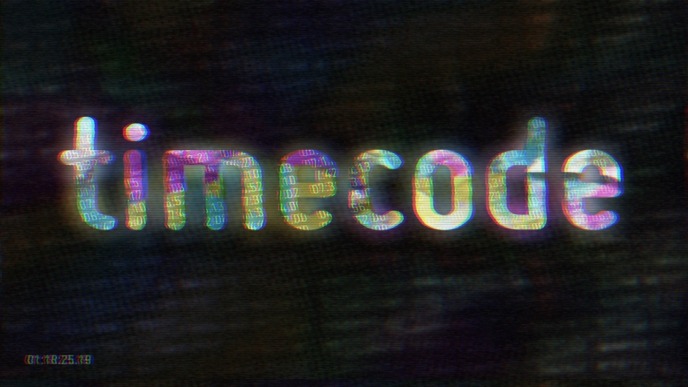
The film slate is an essential device on set – however there are different practices in place on how to use it. Generally speaking, a film slate consists of two main elements: A board that holds hand-written (or sometimes digitally displayed) information and two attached sticks that produce a sound when being clapped together.
A Little History
The idea of using a board to label and identify a clip already originated during the early days of silent film. With the emergence of sound, however, came the need for an additional acoustic identifier and the clapper was born: Clapping the sticks together at the beginning of a take, made it easier to sync visuals and separately recorded audio later on. While the clapper was invented in Australia, the idea of combining both board and clapper into one device developed in the USA.

Back to Today
Since then, slates and slating practices have diversified across the globe. One can witness not only regional differences but also production-specific requirements impacting how film professionals use the device. It’s not uncommon that these different approaches lead to questions or confusion, especially when moving from production to production.
In this article, DITs from different parts of the world share their experiences and thus shine some light on current slating practices. Sure, labeling and operating the Slate is the 2nd AC’s responsibility. However, dealing with the resulting metadata is in the hands of the DIT, who uses slate information to associate looks, camera clips, and other assets that belong to the same scene.
Hear It From Your Peers
So without further ado, let’s hear the stories of 5 DITs from different parts of the world:
1. Aaron Picot (USA)

Which slating system do you use?
Aaron: “American”. We start with a scene number, and add the next letter as we progress. For example: Scene 5, 5A, 5B, 5C, etc.
Are there any special practices in your region concerning slating?
Aaron: Recently I worked on a show where we were using 3 different show LUTs, depending on the scene. We would add the LUT name as a tag on the slate. Also, we would use custom framelines at the DP’s request. If we used one, we would add that to the slate as well. These additions to the slate were made in an effort to assist the dailies lab in quickly applying the right LUT and framing settings to each shot. All shots were accompanied by still frame captures from Livegrade, of course. Other helpful information you may find on a slate is MOS, frame rate and shutter angle, to name a few.
In the photo I provided, the slate is for scene “7-11A”. This production was episodic television. So that’s Episode 7, Scene 11A. This seems to be more and more commonplace with episodic TV, but I’ve also seen the episode notated as a slate tag, alternatively. You won’t find this on any other type of production, such as commercials or feature films.
I find that there isn’t one, correct way to implement slate information. As long as it’s easy to read and it works for the show.
How do you use slate info within Livegrade?
Aaron: I use Episode, Scene, Take, Caption, Int/Ext in the global metadata fields. Entering this information at the top of a scene really makes it easy to search for shots and looks later using Smart Groups. I use the Caption field for the description of the scene as found in the script: BEACH HOUSE, POLICE STATION, PLAYGROUND, etc. All of this information will transfer over to Silverstack when using a .plfa workflow to transfer looks and metadata to offloaded media.
Which information do you include in the wildcards for exports?
Aaron: For exports I use the wildcards for “Scene” and “Camera” to create .cdls and still images named like this: 7-11A_ACAM.cdl. That helps the dailies lab apply the right looks to clips and use the still image as visual reference.
____________________________
2. Christiaan van der Knoop (Netherlands)

Which slating system do you use?
Christiaan: Working in the Netherlands I use the European system, I suppose.
Which uses a separate scene and a separate slate box on the slate. So every new camera setting or new lens will result in the slate number counting one up while the scene number stays the same. So where other systems would use 124A / 1 we would use 124 / 1 / 1 (scene 124, slate 1, take 1).
To add to your question, I’ve exchanged views with some 2nd ACs about slating: France and Belgium start each scene with slate 1 again. Our slate number will always keep going up. So this sounds like we have our own system even though I thought that it’s the same.
How do you use slate info within Livegrade and which information do you include in the wildcards, e.g., for the clip-identifier or in exports?
Christiaan: I’m mostly doing commercial jobs so most of the time we don’t even use a slate on those jobs. In case we use a slate, I’m using the slate info for reference stills to match the consecutive shots in the same scene.

How is the slate info used in other processes? How do you pass on slate info to other departments?
Christiaan: When doing feature jobs, we use the slate and take number as a reference to communicate to specific takes/clips. I’m also using slate info as a burn-in in the viewing dailies in the Copra dailies system.
____________________________
3. Timur Gavrilenko (Russia)

Which slating system do you use?
Timur: The image shows how a slate looks like in Russia. It’s “Scene-Shot-Take” based. In this specific scenario, we’re shooting a shot that works with scene 4 and scene 82, “Fb” stands for flashback. This is shot 4 in this scene, “E” stands for English version. On this feature we shot in two different languages, Russian and English.
Are there any special practices in your region concerning slating?
Timur: Russia is a wild place in terms of technique; every script has some odd letters in it and every script supervisor has their own system. I have to adjust and be flexible.
How do you use slate info within Livegrade and which information do you include in the wildcards, e.g., for the clip-identifier or in exports?
Timur: These are all the metadata fields I fill out in my Livegrade interface:
- Global Metadata fields:
- “Day”, “Scene”, “Shot”, “Take”.
- “Unit” or “Episode” metadata fields can be added into here as well, if there are multiple units with DIT’s or it’s a long term project with episodes.
- Then “Location” as it’s written in the call sheet or script.
- “Day/Night”, “Int/Ext”.
- And rarely do I have a use for “Caption“. Usually I use that on cinematography image tests, mentioning what exactly were we testing here (e.g.: Underexposed 3 stops, Lens breathing test, etc.)

- Per camera (in Livegrade slot) :
- Lens (e.g. MP35)
- Filter (e.g. BPM 1/4)
- Aperture (e.g. 5.6)
How is the slate info used in other processes? How do you pass on slate info to other departments?
Timur: Usually, this info is only for me and for the DP so we can quickly find the shot that we need. The script supervisor keeps track of all scenes globally. I don’t pass it along anywhere.
____________________________
4. Ryan McGregor (Canada)

Which slating system do you use?
Ryan: I mostly work on bigger budget TV series here in Vancouver. We use the standard “American” style of slating, I suppose, i.e.: Scene 32, then 32A, 32B, etc. We separate the episode number from the scene number, so a small tag with Ep 106, then the scene number.
How do you use slate info within Livegrade and which information do you include in the wildcards, e.g., for the clip-identifier or in exports?
Ryan: Within Livegrade, I use the shot section within the Global Metadata to assign A, B, C, etc. With “_” for the first shot of a scene. By doing this, it helps to keep the Smart Groups clean and organized by “Episode” then “Scene”, “Shot” then “Camera”.

Livegrade’s Smart Groups have literally revolutionized how I search for shots and organize throughout the day. Between Smart Groups and the ability to edit multiple shots metadata at the same time now, it’s very quick and efficient to edit throughout the day and correct my mistakes.
Below is also a screenshot of the metadata categories I capture per shot. Many filled automatically via the ancillary metadata sent from the Alexa MiniLF/LF via Teradek Bolt XTs.

How is the slate info used in other processes? How do you pass on slate info to other departments?
Ryan: I use wildcards for naming conventions to export my CDLs and stills for each film break. My naming convention can be viewed in the screenshot below. Custom 2 is the name of the LUT I’m using for easy communication with the lab. Therefore, for Episode 106, Scene 32B, the filename would look something like:
“106_32B_A_YJ_1990”
That’s short enough to fit within Colorfront’s software as a look while providing all the necessary info.
What are the benefits of the slating improvements in Livegrade v.5.4 from your perspective?
Ryan: The exclusion of shot letters has been very useful, i.e.: I, O, etc. It would be nice to have a shot prefix for visual or 2nd unit shots that start with V or X but don’t necessarily screw up the alphabetical order of the Smart Groups.
____________________________
5. Andy Bader (USA)

Which slating system do you use?
Andy: I use the American system of slating for all of my narrative work.
The most important info on our slates is camera ID, roll number, scene number (which, with the postfix, includes the setup information, kind of our “shot number”, even though it’s a letter), and “take number”.
We also indicate frame rate, date, timecode of course, and LUT if there are multiple. Above is a pic of a slate of my current show.
Can you share any peculiar story around slating?
Andy: When I was a 2nd AC, I had a big picture of myself tail slating in the local newspaper. I was pretty excited about it, until I realized that if you don’t realize tail slating technique, it looks like I was too dumb to know I was holding the slate upside down. Also, we’ve shot a lot of driving work in front of LED walls recently, which makes for some good running slate gags.
How do you use slate info within Livegrade (e.g., Smart Groups, etc.), and which information do you include in the wildcards, e.g., for the clip-identifier or in exports?
Andy: I use all the slate information for my CDL names and my frame grabs. Here’s my current setup:
- OKOP-Ep101-Sc10A-Tk1-A_Cam.cdl (show abbreviation, episode, scene number including setup, take, camera)
How is the slate info used in other processes? How do you pass on slate info to other departments?
Andy: Mostly, the file naming info is to pass info to the post team, so they know what take to apply it to. It also helps me to organize my frame grab collection and make it easily searchable.
What are the benefits of the slating improvements in Livegrade v.5.4 from your perspective?
Andy: The slating system change is simply such a nice quality of life improvement. I’m able to integrate my Streamdeck into my system so much more, and I have to type less, meaning I can pay more attention to my work.
Outro
Although slating guidelines vary greatly depending on region, user-established workflows, and production guidelines, slate info is key to organizing any relevant data for all film productions.
Hence, Livegrade provides a highly flexible toolset with dedicated slating preferences, menu items, and controller actions to streamline the process for your preferred slating method. In addition, the smart groups let you create powerful metadata views based on your slate info and make it easy to reveal shots for reference or prepare exports. Finally, the wildcards and the report and look archive exports provide neat ways to share shots, including slate info with other departments, and ensure a well-organized production right from the beginning.
So keep on slating – it can be a lot of fun:
Thanks to Chris Bolton for referring this video.
What Is New in Livegrade Studio?
Check out all new features and highlights of the latest release.



